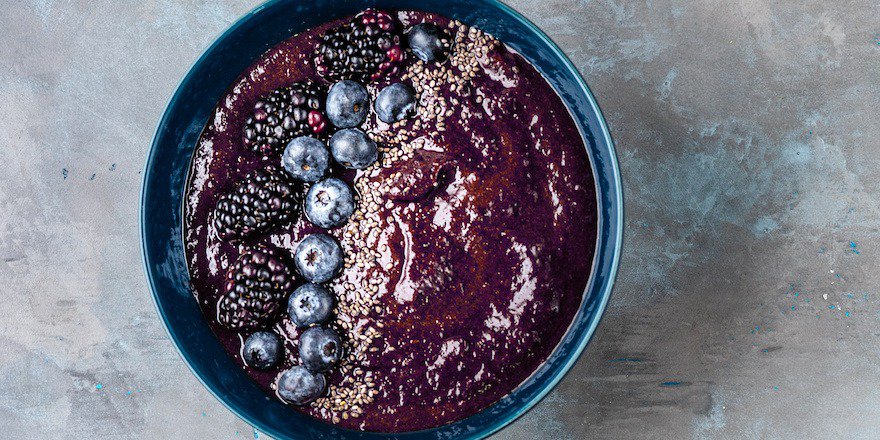BENEFITS OF AÇAÍ
✓ A wealth of antioxidants
✓ Protects the heart
✓ May help with weight loss
✓ Role in cancer prevention
What is açai?
Açaí (Euterpe oleracea) is a tall palm tree native to the tropical regions of South America, particularly Brazil (like guarana). Açaí also refers to the purple berries that grow at its top, which the indigenous peoples of the Amazon have been consuming since pre-Columbian times for their tonic properties.
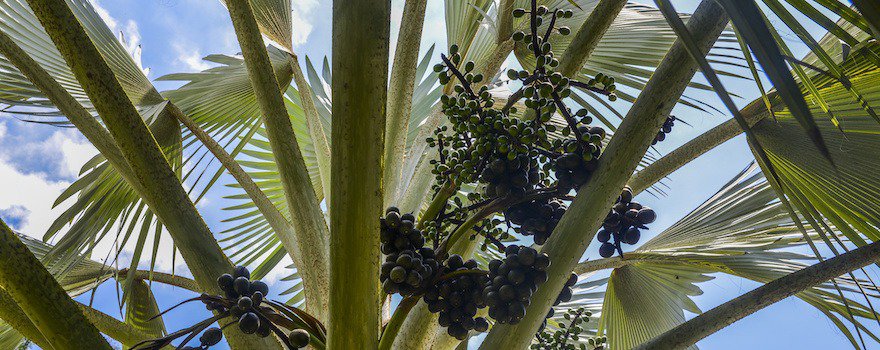
The açaí palm is very slender but can reach up to 20 meters tall. It grows in the humid forests of South America, mainly in Brazil, but also in Ecuador, Venezuela, Guyana, Suriname and Peru. The berries are harvested by hand: pickers climb the trees using natural fiber ropes and collect the clusters of fruit.
The berries are very fragile. While pickers and local populations can eat them fresh, people farther from the açaí palms — that is, the rest of Brazil and the world — can only access their pulp frozen as a purée. They are also available as powder, after being dried and ground.

Why such enthusiasm given the fragility, the difficulty of extracting and preserving acai berries? It must be acknowledged that their intense purple color is quite photogenic, as evidenced by the proliferation of acai bowls on Instagram and other blogs. But their success relies mainly on the many benefits attributed to them.
First, a remarkable richness in polyphenols, those antioxidants that give them their fascinating color and help us fight free radicals and aging.
But also because acai berries have an exceptional nutritional density. Rich in fiber, in protein, in minerals and trace elements, they provide a noteworthy percentage of the RDIs (recommended daily intakes) for many nutrients. Finally, they contain very little sugar!
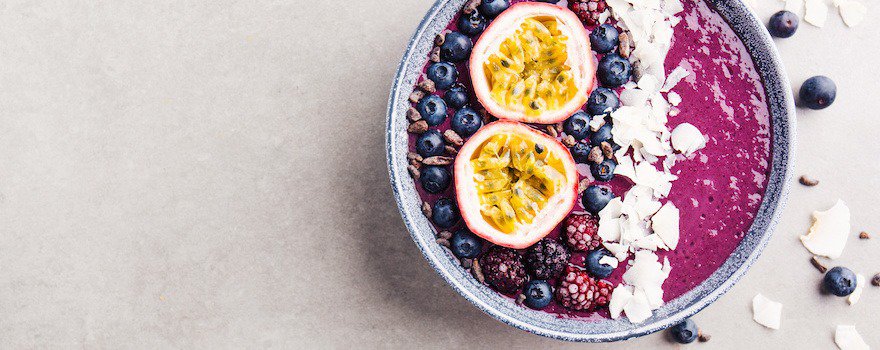
Nutritional composition
- Proteins
- Fatty acids: omega-9, omega-6
- Fiber
- Vitamins B1, E
- Minerals and trace elements: potassium, calcium, phosphorus, magnesium, manganese, iron, sodium, zinc, copper
- Polyphenols: flavonoids
Açai benefits
★ A treasure trove of antioxidants
The antioxidant capacity of acai measured by the ORAC (Oxygen Radical Absorbance Capacity) reaches 12,324 µmol TE/100g of fruit. This represents three times the antioxidant activity of blueberries, which are already champions in this area.
It contains 3.29 g of polyphenols per 100 g of dry matter. Among these polyphenols are notably the anthocyanins, flavonoids that color the fruits, specifically those that give açai berries their purple color. These antioxidants are also found in another small fruit native to the Amazon, acerola.
These antioxidants will significantly reduce the action of free radicals on our cells, protecting them from oxidative stress and aging.
This study from the Institute of Nutritional and Food Sciences in Bonn, Germany analyzed the performance of the polyphenols contained in açai pulp.
★ Protects the heart
Açai protects the heart, notably thanks to its anti-cholesterol properties. Cholesterol is one of the major causes of cardiovascular disease.
The anthocyanins it contains help lower LDL cholesterol levels—the bad cholesterol—while the beta-sitosterols it also contains prevent the body from absorbing it.
This pilot study by Medicus Research LLC in Canada, conducted on 10 overweight individuals, showed that consuming açai smoothies twice a day for one month helped lower their LDL cholesterol levels.
★ May help with weight loss
This benefit is highly debated. Some manufacturers regularly label açaí berries as a “weight-loss product”. However, no scientific study has yet proven this claim; for now it’s purely marketing.
But their high fiber content, 30 g per 100 g of dry matter, may produce a feeling of fullness and an appetite-suppressing effect. In addition, they are low in calories.
★ Role in cancer prevention
Açai is the subject of many investigations into cancer prevention. Indeed, its components could help fight the spread of cancer cells.
However, so far the scientific studies have only been conducted in vitro or on animals.
This study, an in vitro study from Texas A&M University, demonstrated that açaí polyphenols could naturally prevent colon cancer.
How to consume açaí?
This is generally where the problem lies, because açaí-based products often contain additives, including a huge amount of sugar. We always read the labels carefully and choose the right product! And we prefer an organic and fair-trade origin when possible.
Açaí bowl
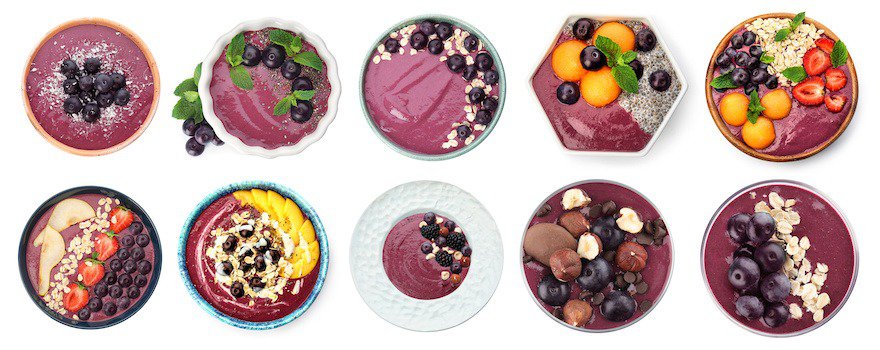
The açai bowl is undoubtedly the dessert that gave this fruit its current fame. It is an invention from Rio de Janeiro in the 1980s attributed to the founder of Brazilian Jiu-Jitsu, Carlos Gracie. The practice of this martial art required a protein-rich, invigorating diet, and the açaí bowl, made of frozen açaí pulp and banana, was supposed to strengthen athletes.
Very quickly the açaí na tigela (in Portuguese) won over other disciplines, notably surfing. The concept was popularized by surfers from California and Hawaii, before becoming a worldwide trend.
Today you can find açai bowls everywhere, especially in restaurants and vegan coffee shops. Açaí is even called “the fruit of globalization”, with all the potential excesses that can come with it!
Good news — you can just as easily make them yourself, and açai bowl recipes are simple to prepare! They are perfect for breakfast as well as afternoon snack. To make them, blend 200g of frozen açai pulp, half a banana and a little honey in a blender. Pour into a nice bowl and add your favorite toppings: banana slices, berries, granola, nuts, mint…
Açaí powder
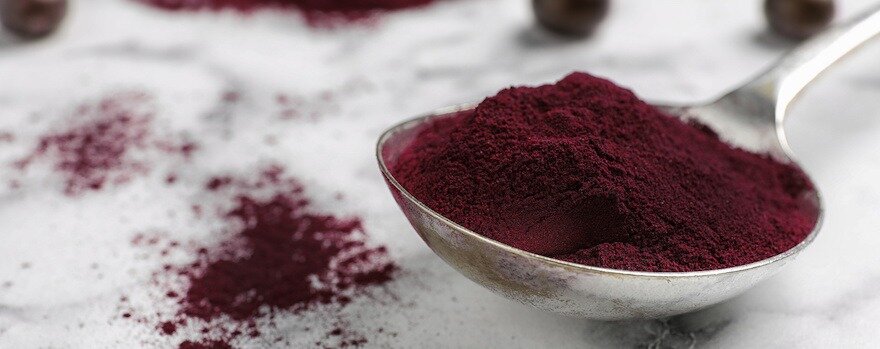
You get açai powder from dried berries, crushed and cold-milled into powder. You can easily find it in health food stores or online. To add it to your diet, you can sprinkle it on your yogurts, smoothies and other fruit salads.
Açaí juice
Another way to consume them is to drink them as juice. Again, always check the labels carefully. You will often find very sweet mixes on the market where the açai content is low. However, you should know that pure açai juices are relatively expensive!

Dosage
There is no specific recommended dosage for açai berries. As with any food, it is advised to avoid excess — beware, their chocolatey red-berry flavor can lead you to consume more than is reasonable!
Contraindications and side effects
Again, no contraindications or side effects have been observed.


